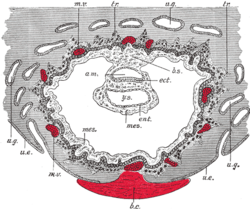- Extra-embryonic coelom
-
Extraembryonic coelom The extraembryonic coelom (or chorionic cavity) is shown between the two layers of extraembryonic mesoderm (labelled "mes.") in this image of an implanted embryo. Latin coeloma extraembryonicum, cavitas chorionica Carnegie stage 6a Days 12 Precursor Heuser's membrane Code TE E5.8.0.0.1.0.1 The extraembryonic coelom (or Chorionic cavity)[1] is a portion of the conceptus consisting of a cavity between Heuser's membrane and the Trophoblast.
During formation of the primitive yolk sac, some of the migrating Hypoblast cells transdifferentiate into mesenchymal cells that fill the space between Heuser's membrane and the Trophoblast, forming the extraembryonic mesoderm . As development progresses, small lacunae begin to form within the extraembryonic mesoderm which become larger and form the extraembryonic coelom.
It divides the extraembryonic mesoderm into two layers: extraembryonic splanchnopleuric mesoderm, which lies adjacent to Heuser's membrane around the outside of the primitive yolk sac, and extraembryonic somatopleuric mesoderm, which lies adjacent to the cytotrophoblast layer of the embryo.
The extraembryonic coelemic cavity is also called the chorionic cavity, and is enclosed by the chorionic plate, which is composed of an inner layer of somatopleuric mesoderm and an outer layer of trophoblast cells.
References
External links
- http://isc.temple.edu/marino/embryology/EMBI97/img015.GIF
- http://www.embryology.ch/anglais/hdisqueembry/triderm09.html
- http://sprojects.mmi.mcgill.ca/embryology/earlydev/week2/eemes&coel.html
Prenatal development/Mammalian development of digestive system, coelom and septa, and mesenchymal mesenteric masses (GA 11.1101, TE E5.4, 5.8-9) Gut Upper GI tract and accessoryForegut: upper GI (Buccopharyngeal membrane, Rathke's pouch, Tracheoesophageal septum) · accessory (Pancreatic bud, Hepatic diverticulum)Abdominopelvic OtherIntra-embryonic coelom · Extra-embryonic coelom
This anatomy article is a stub. You can help Wikipedia by expanding it.

